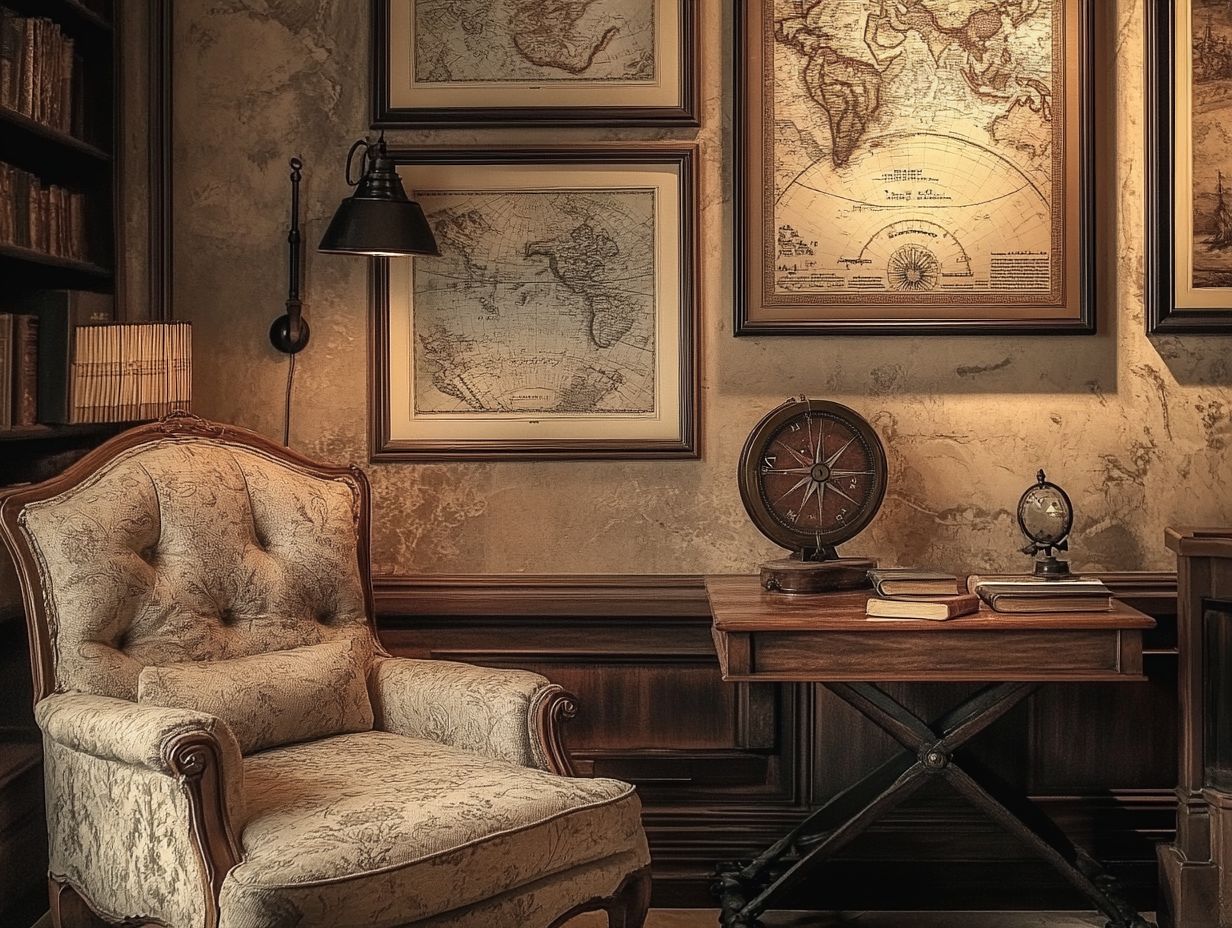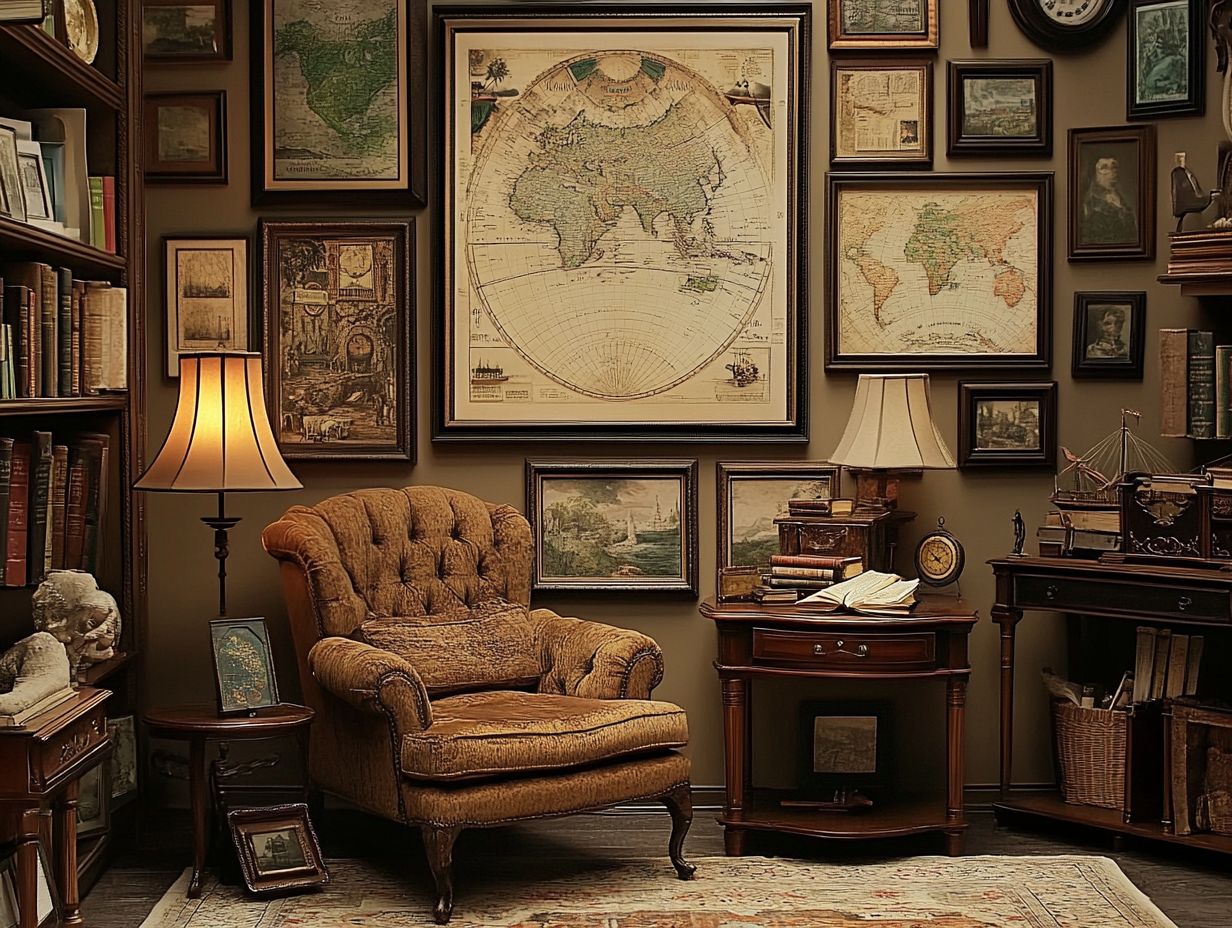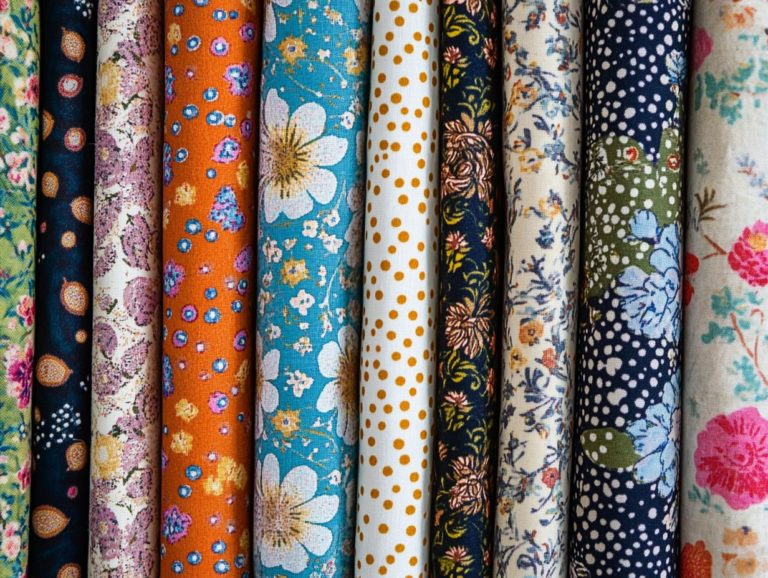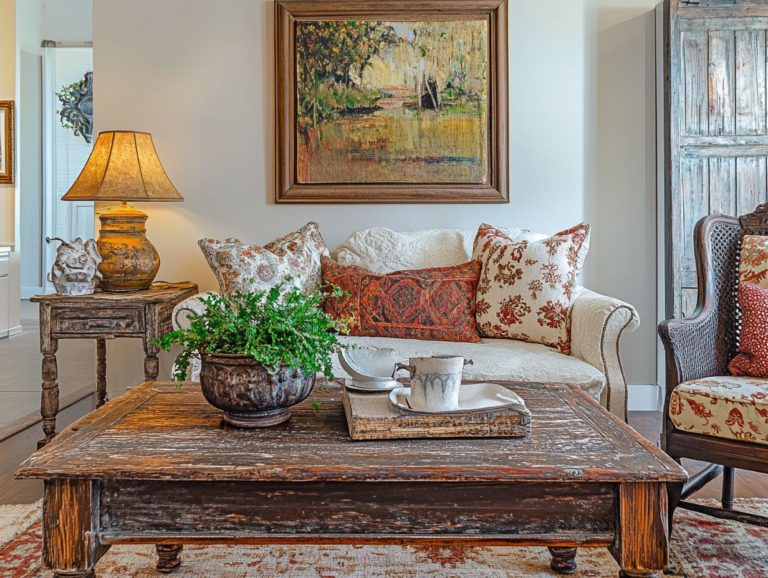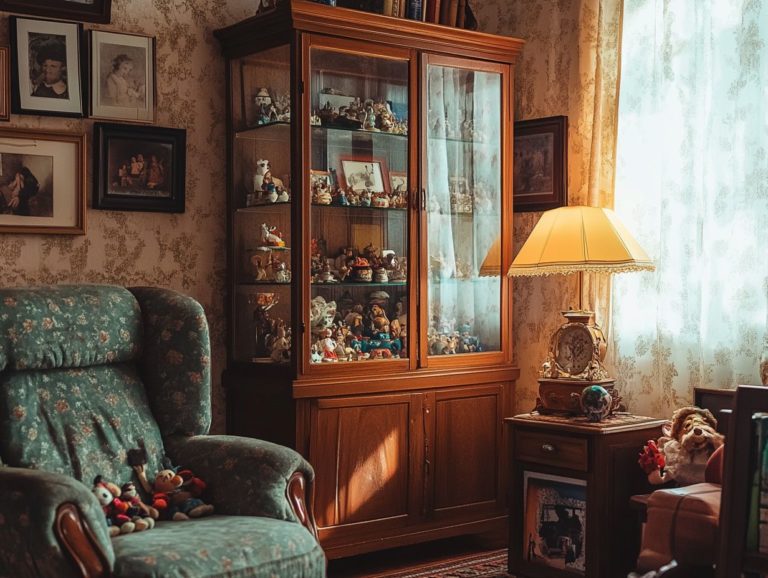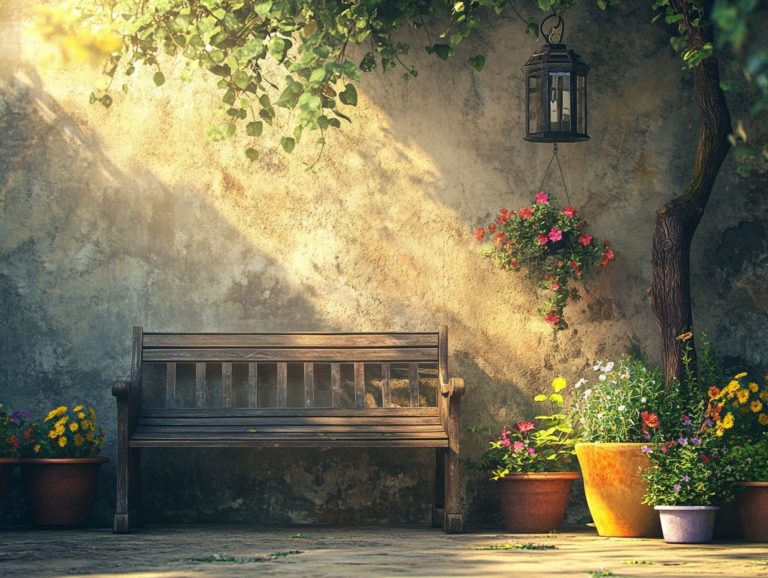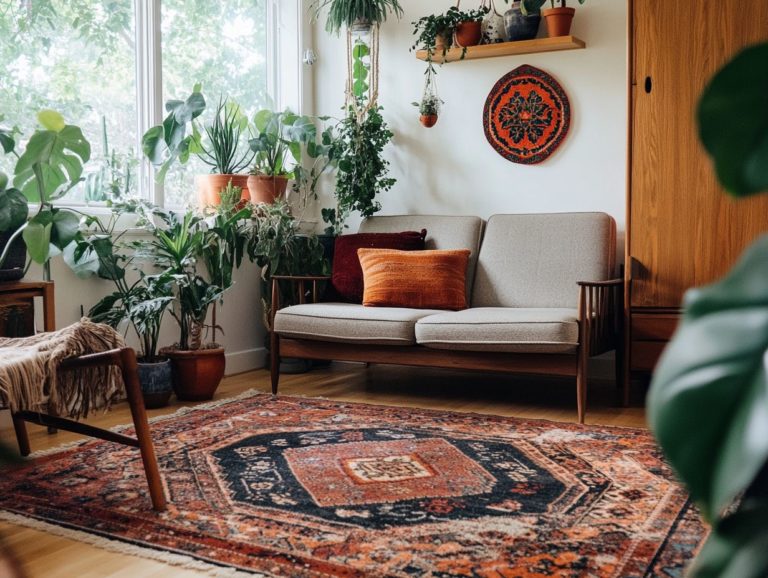How to Create a Vintage Style with Antique Maps
Vintage style evokes a sense of nostalgia and charm. Antique maps are a perfect way to bring this vintage aesthetic into your home decor.
With their rich history and artistic allure, antique maps tell stories that transcend time. They showcase the evolution of cartography.
Explore the origins of these captivating pieces. Find tips for incorporating them into your decor, discover creative DIY projects using high-resolution images, and learn essential care advice.
Bring your space to life with the captivating charm of antique maps! Don’t miss out on this beautiful addition.
Contents
- Key Takeaways:
- History of Antique Maps
- Using Antique Maps in Home Decor
- DIY Projects with Antique Maps
- Finding and Choosing Antique Maps
- Caring for Antique Maps
- Creating a Vintage Style with Antique Maps
- Frequently Asked Questions
- 1. How can I incorporate antique maps into my home decor to create a vintage style?
- 2. What are some ways to display antique maps in a creative and unique way?
- 3. How can I ensure that the antique maps I purchase are authentic and in good condition?
- 4. Can I use antique maps from different regions or time periods to create a cohesive vintage style?
- 5. How can I preserve and protect my antique maps for long-term display?
- 6. Are there any DIY projects I can do with antique maps to create a vintage style?
Key Takeaways:
- Embrace the history and nostalgia of vintage style with antique maps that add character and charm to any space.
- Display antique maps creatively throughout your home and explore DIY projects.
- When buying antique maps, choose reputable sellers and consider each map’s condition and unique features for a cohesive vintage style.
What is Vintage Style?
Vintage style embodies a distinctive aesthetic that often incorporates elements from previous decades. It effectively blends nostalgia with contemporary design principles.
The appeal of vintage pieces lies in their capacity to evoke memories while offering authenticity in home decor.
This style frequently features antique items, ranging from furniture to artwork. These pieces are characterized by muted colors, intricate designs, and materials that reflect a bygone era.
Vintage-inspired decor enables homeowners to infuse their spaces with personal history and creativity, making each room feel unique.
A closer examination of vintage themes reveals influences from various historical periods, including the Art Deco movement of the 1920s and the rustic charm of mid-century modern designs.
These eras introduced vibrant patterns and textures, utilizing colors such as deep greens, burnt oranges, and soft pastels to create a timeless palette within contemporary spaces.
Elements like cartography—a common motif in vintage prints—add a narrative dimension. They allow the art of travel and exploration to influence personal decor.
As modern design trends increasingly prioritize sustainability, the resurgence of vintage style serves as a mode of creative expression and a tribute to craftsmanship from previous generations.
History of Antique Maps
Antique maps have a fascinating history. They show how cartography evolved from basic navigation tools to detailed world representations.
A notable figure in this field is Johann Christoph Matthias Reinecke. His works are housed in esteemed collections such as the Library of Congress and the US Library of Congress Map Collection.
These maps also served as artistic expressions of their time, illustrating the boundaries and features of diverse regions.
Origins and Evolution of Antique Maps
The origins of antique maps can be traced back to ancient civilizations. Early cartographers began documenting the world through rudimentary sketches.
As geographical knowledge expanded, these sketches evolved into more sophisticated designs.
Over the centuries, advancements in technology, including the invention of printing techniques and the use of high-resolution images, significantly enhanced the accuracy and detail of maps.
These developments improved the reliability of maps for navigation and transformed them into works of art, showcasing intricate designs and geographical features.
During the Renaissance, the introduction of perspective drawing and more systematic approaches to surveying marked a significant turning point in mapmaking.
This period saw the emergence of detailed world maps, such as those created by Gerardus Mercator, whose projections revolutionized maritime navigation due to their historical accuracy.
With the age of exploration, technological progress continued, leading to the development of thematic maps that depicted not only physical landscapes but also cultural and political aspects.
Each era contributed to the expanding field of cartography. Modern advancements, such as GPS and digital mapping, have further enhanced the precision and accessibility of geographical information.
Using Antique Maps in Home Decor
Incorporating antique maps into home decor introduces a unique blend of history and sophistication. They serve as focal points and conversation starters.
These vintage pieces come in various styles and colors. They enhance interior designs while adding layers of texture and depth.
With options for elegant framing from stores like Amazon and Ikea, along with innovative placements, antique maps can be seamlessly integrated into living rooms, studies, or hallways.
These maps become essential components of home decor that reflect individual style and interests.
Incorporating Antique Maps into Different Rooms
Incorporating antique maps into various rooms of a home can create unique vibes that cater to diverse styles and functions. This enhances overall decor while reflecting individual preferences.
For example, in living rooms, large vintage maps can serve as striking focal points that evoke nostalgia. Smaller, framed maps in studies or offices can inspire creativity and productivity.
The selection of colors and styles can complement existing decor, allowing antique maps to blend harmoniously with both modern furnishings and classic designs.
In a rustic kitchen, colorful, aged maps beautifully enhance wooden cabinetry and farmhouse decor. Their vintage hues resonate with the warmth of the space.
In bedrooms, soft-toned maps introduce an element of wanderlust, while neutral palettes contribute to serene and inviting environments.
Hallways or entryways can benefit from a gallery wall of assorted maps, showcasing geographical diversity and a unique narrative that reflects the homeowner’s travels and interests.
By thoughtfully selecting the size and framing styles of these maps, one can create cohesive themes that seamlessly integrate various elements within each room. Utilize digital tools to enhance visual effects.
DIY Projects with Antique Maps
Dive into exciting DIY projects with antique maps! Engaging in do-it-yourself projects enables individuals to express their creativity while repurposing these exquisite artifacts into functional decor items.
The potential applications are numerous, ranging from the creation of unique wall art to developing personalized gifts.
You can use antique maps for framed prints or collages, employ them as wrapping paper, or integrate them into furniture designs. This not only enhances the aesthetic appeal with a vintage touch but also preserves the historical significance of these maps.
Creative Ways to Use Antique Maps
There are numerous creative methods to incorporate antique maps into home decorations and projects. Transform them into functional art that conveys a narrative.
For instance, you can utilize vintage maps to create unique coasters, placemats, or even decoupage furniture. This enhances the character and charm of any space.
You can also use antique maps to craft personalized gifts, such as framed art pieces or custom greeting cards, allowing their beauty to shine through in various applications.
You could create a striking gallery wall that combines different antique map designs, showcasing a rich tapestry of geography and history. This feature serves as a conversation starter and introduces an element of wanderlust into your home.
Moreover, incorporating maps into scrapbooking provides an excellent opportunity to capture travel memories. Integrate stunning visuals with cherished experiences.
With a touch of creativity, you can even use these maps for gift wrapping, transforming every present into a unique work of art that reflects personal journeys and connections.
Finding and Choosing Antique Maps
Identifying and selecting the right antique maps can be a gratifying pursuit. These items possess historical significance and aesthetic value that can enhance any decor, especially when sourced from reputable libraries or online marketplaces.
Numerous sources, including online marketplaces, antique shops, and institutions such as the Library of Congress, provide a wide array of maps to accommodate diverse tastes and styles.
Whether you favor meticulously preserved prints or distinct designs illustrating historical boundaries, choosing the ideal antique map can instantly elevate your space and enrich your personal narrative.
Where to Buy and What to Look For
When purchasing antique maps, it is crucial to know where to search and which qualities to prioritize. This ensures you acquire pieces that are both genuine and visually appealing.
Exploring eclectic markets or estate sales can yield unique finds that may not be available online. You might uncover rare treasures with significant historical value and authentic craftsmanship.
Look for signs of restoration when examining a map. Reputable dealers should provide documentation that establishes its history. Understanding the extent of any repairs is essential for accurately evaluating quality. For authentic examples, consider resources like the Library of Congress.
By taking these factors into account, you can make informed decisions that enhance both the aesthetic and historical value of your collection, especially when using various design techniques.
Caring for Antique Maps
Caring for antique maps is essential to preserve their historical integrity and visual appeal. Proper preservation keeps these delicate artifacts vibrant and intact over time.
Utilize acid-free paper to avoid damage. Understanding appropriate storage methods, climate control, and cleaning techniques enables antique maps to be appreciated as both art and significant historical documents within your home. Use digital tools for cataloging and documentation.
Tips for Preservation and Maintenance
To effectively preserve antique maps, adopt proper maintenance strategies that ensure their longevity and continued aesthetic appeal. Techniques such as using acid-free storage materials, avoiding direct sunlight, and maintaining stable temperature and humidity levels can significantly enhance preservation.
Regular cleaning and gentle handling are crucial, enabling you to appreciate these historical artifacts without compromising their integrity. Consider using a spray to lightly mist the surface during cleaning.
Implement a routine inspection schedule to identify any signs of deterioration, such as fading, tears, or discoloration. Use a soft, dry brush to carefully remove dust and debris, avoiding harsh chemicals that may damage the paper. If using any cleaning solutions, opt for gentle filters.
For storage, employing flat archival boxes is highly recommended, as they offer both protection and easy access. Check out Amazon or Ikea for the best storage solutions that keep your maps safe and sound!
Start preserving your antique maps today to enjoy their beauty for years to come!
Creating a Vintage Style with Antique Maps
To create a vintage style with antique maps, you need a thoughtful approach to their use in your decor. This allows their historical significance and artistry to enrich your living space. Using images of maps for inspiration can help guide your design choices.
Employ various design techniques, such as layering textures and selecting colors that harmonize with the maps. This can establish a cohesive aesthetic that embodies nostalgia and elegance. Consider utilizing software like Adobe Illustrator for your projects.
Antique maps can serve as the foundation of a room’s design, influencing decisions regarding furniture selection, wall colors, and decorative elements. They can also be part of a larger collection that showcases different styles and themes.
Design Tips and Inspiration
When designing with antique maps, draw inspiration from various styles and themes to create a unique and personalized aesthetic in your home. Consider framing techniques that enhance the map’s features, such as using vintage-style frames or creating a gallery wall to showcase multiple pieces. Using high-resolution images ensures quality displays.
Incorporate maps in unexpected locations, such as a study or hallway, to serve as conversation starters. Mixing and matching different styles of maps—ranging from topographical to nautical—adds visual interest. You might also consider using digital versions for a modern aesthetic.
Surround the maps with objects that reflect their historical significance, such as antique compasses or globes. This can create a cohesive theme that narrates a story of adventure and exploration. Using advanced display techniques can enhance how the maps look.
Frequently Asked Questions
1. How can I incorporate antique maps into my home decor to create a vintage style?
To create a vintage style with antique maps, use them as wall art, frame them for display on shelves, or even use them as wallpaper. You can also use them as accents, such as on throw pillows or as covers for notebooks or journals. Consider sourcing maps from the US Library of Congress Map Collection or online platforms like OldMapsOnline.org.
2. What are some ways to display antique maps in a creative and unique way?
Imagine creating a stunning gallery wall with an array of maps that spark conversation! Other ideas include using them as a table runner for a vintage-themed party or decoupaging them onto furniture for a one-of-a-kind piece. You can also use antique maps as the backdrop for a shadow box filled with vintage trinkets and souvenirs. Incorporate fonts that complement the maps for added flair.
3. How can I ensure that the antique maps I purchase are authentic and in good condition?
When purchasing antique maps, buy from reputable sellers and ask for a certificate of authenticity. Thoroughly inspect the map for any tears, stains, or discoloration. If possible, request a close-up photo or see the map in person before making a purchase. Using resources like Google Images for comparison can also help.
4. Can I use antique maps from different regions or time periods to create a cohesive vintage style?
Absolutely! Mixing and matching antique maps from different regions and time periods can add an eclectic touch to your vintage decor. Look for maps with similar color palettes or themes, like nautical maps or maps of a specific country. For added depth, consider using different layers of paper and textures in your display.
5. How can I preserve and protect my antique maps for long-term display?
To preserve antique maps, frame them using UV-resistant glass or plexiglass to protect them from fading. Store them in acid-free folders or sleeves, and avoid displaying them in direct sunlight or areas with high humidity. Handle them with clean hands and avoid using tape or adhesive when framing or displaying them. If printing maps for personal use, ensure quality by checking the DPI settings.
6. Are there any DIY projects I can do with antique maps to create a vintage style?
Absolutely! You can create unique coasters or placemats using antique maps.
Other fun projects include decorating mason jars or making a map-covered lampshade. You could even use them as a backdrop for a vintage-inspired scrapbook or journal!
The possibilities are endless. For added durability, consider using printing techniques.

